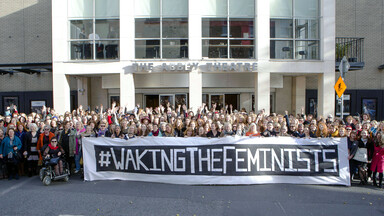The Waking the Feminists (WTF) campaign, which began in November 2015, shone a spotlight on gender inequality across the Irish theatre sector and inspired a movement that continues to influence cultural life today.
To mark this important 10th anniversary, the National Library of Ireland (NLI) is delighted to share a newly catalogued selection of photographs from the Waking the Feminists Collection. The selection, developed in collaboration with campaign coordinator Lian Bell, captures key moments from the movement, from the early rallies and Abbey Theatre events to the community of artists, activists, and audiences who came together under the banner of equality.
The photographic collection helps present the full story of the #WakingTheFeminists campaign, complementing the existing Special Collections holdings, which include ephemera as well as printed and manuscript material related to the campaign.
A Decade of Change and Reflection
The NLI began acquiring the Waking the Feminists Collection in 2019. Over the years, the Library has worked with Lian Bell and the campaign supporters to preserve both the visual and textual record of this landmark movement. The collection is born digital and includes photographs and documentation that trace the campaign’s growth and impact, alongside the Gender Counts report that emerged from the initiative.
“It’s wonderful to see these images preserved and made available to the public,” said Della Keating from the Digital Collections team. “They showcase the raw emotion and raw ingredients that tell the story not only of an influential campaign, but of a community determined to make the arts more equal and inclusive.”
Highlights from the Collection
The images chosen to mark the 10th anniversary were selected collaboratively by Lian Bell and the NLI’s Digital Collections team. They represent only a small portion of the larger Waking the Feminists Collection currently being processed.
The selection includes:
-
The original Facebook post that sparked the conversation around equality for women in Irish theatre.
-
An accidental but symbolic photograph taken before the first public meeting.
-
The iconic photocall outside the Abbey Theatre ahead of that meeting.
-
Regional gatherings of women working in arts and theatre in Galway and Limerick for Nollaig na mBan, January 2016.
-
A never-produced mug design, complete with its backstory.
-
The second mass meeting of campaigners in Spring 2016.
These moments, large and small, tell the story of a short-lived but impactful grassroots campaign that captured a nation’s attention and helped reshape Irish theatre.
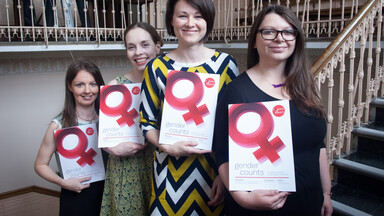
Four of the lead researchers at the launch of Gender Counts in June 2017, the groundbreaking study on gender in Irish theatre conducted by #WakingTheFeminists. It established clearly the (in some cases profound) inequality present in Irish theatre, and set a baseline against which all future research can be measured. Gender Counts was funded in part by the Arts Council, but the vast majority of work by the six lead researchers was voluntary. Pictured are Dr Ciara O’Dowd, Dr Brenda Donohue, Dr Tanya Dean, and Ciara Murphy. Photo: Kate Horgan
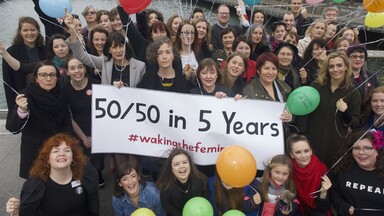
Photocall on the Rosie Hackett Bridge in Dublin featuring all the speakers for One Thing More at the Abbey Theatre on 14 November 2016. One Thing More was the closing event of the campaign, almost exactly a year after it began, where the core group formally handed responsibility for gender equality back to the theatre community. It was followed that afternoon by an unprecidented meeting of theatre organisations and funders to discuss how they would take on the responsibility for achieving gender equality. That meeting led to, amongst other things, the Gender Equality Policy Working Group being formed, where ten major organisations met for over a year to plan their first ever equality policies, which were published in 2018, changing Irish theatre fundamentally. Photo: Kate Horgan

Placard made by Tara Derrington for the first public meeting at the Abbey Theatre, 12 November 2015 saying 'Where are the DISAPPEARED women of the arts?... At the school gates now'. Tara Derrington went on to be a founding member of Mothers Artists Makers (MAMs), a grassroots support community for parenting artists.
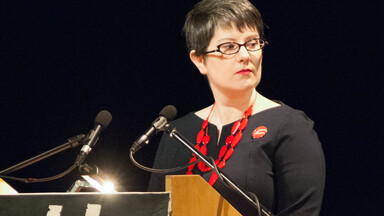
Core team member Sarah Durcan speaking at the second public meeting in Liberty Hall on International Women's Day. She and Dr Brenda Donohue gave a presentation about unconsious bias (which was a new concept to many people at the time) and the need for research into gender in Irish theatre. Sarah, with Lian Bell, recently published the definitive book about the campaign titled WTF HAPPENED. Photo: Kate Horgan

Women working in theatre and the arts in Galway gather for Nollaig na mBan 2016 at Tigh Neachtain. Organised by feminists across the country (and internationally) on 6 January, the self-organised Nollaig na mBan/Women's Christmas events were a way for the grassroots supporters of #WakingTheFeminists to gather, discuss, and celebrate the movement, wherever they were based. On the far right of the photograph, holding the final S, is Ionia Ní Chróinín of Moonfish Theatre who gave a speech in Irish at the first #WakingTheFeminists public event at the Abbey. Photo: John Rogers
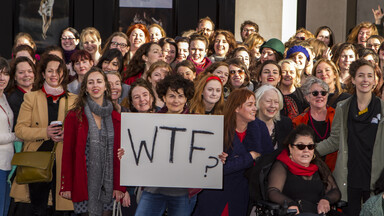
Actor Pom Boyd brought her own WTF? placard to the Abbey Theatre before the first major public event, 12 November 2015. It's hard to convey the hightened energy of the day - such joy, anger, excitement, and hope among a group of people of all ages who felt they were finally taking their place, and being listened to. The name #WakingTheFeminists was a happy accident: Lian Bell, in the first hours of the social media storm, needed a hashtag to mark tweets with. At the time many people were making fun of the Abbey Theatre's male-focussed programme called Waking The Nation which had been the catalyst for the movement; one theatre director, Maeve Stone, had tweeted 'Waking The Feminists', and Lian decided quickly to use that as a hashtag. It was only days later when someone pointed out that it was also, aptly, WTF. Photo: Tamara Him
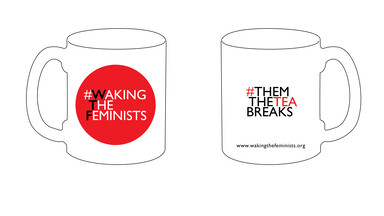
Playwright Kate Heffernan speedily designed badges that were handed out at the first public meeting. The bold design quickly became the logo of the campaign. To help raise funds to cover some of the campaign's costs, Kate later went on to design mugs and tote bags. This is a mug design that didn't get made. Playing on the infamous tweet by Fiach MacCongail, Director of the Abbey, to defend his lack of women artists in the theatre's 2016 programme which said "sometimes plays and ideas that we have commissioned by and about women just don’t work out. That has happened. Them the breaks." At the time that Kate designed this, the campaign was still at a precarious moment and we were carefully watching every move we made, so some of the core group decided that it was still a little too soon to poke fun - which is a pity.

In New York, the night before the first major public meeting on 12 November 2016, Irish playwright Lisa Tierney Kehoe (left) spotted Meryl Streep at an event and managed to get this photograph with her and fellow actors Christine Baranski and Laoisa Sexton. When Lisa shared it on social media, the attention given to #WakingTheFeminists by media in Ireland and internationally skyrocketed, instantly giving the campain more visibility and more power. Lisa went on to become the 'New York chapter' of #WakingTheFeminists, making connections and putting pressure on from across the Atlantic. Photo: Lisa Tierney Kehoe

From the first few days of the movement, #WakingTheFeminists supporters used their networks around the world to get 'famous faces' to tweet a photograph of support; the Irish film and theatre community are very well networked. One of the first international tweets of support came from actor Rose Byrne; this may have been the work of actor Brían F O'Byrne who was in LA at the time and very active in drumming up support for the movement. As the photos of support piled in, more attention was paid to #WakingTheFeminists by media, nationally and internationally, giving the campaign more power to put more pressure on the Abbey Theatre and other theatre organisations to make significant and lasting changes to the way they worked.
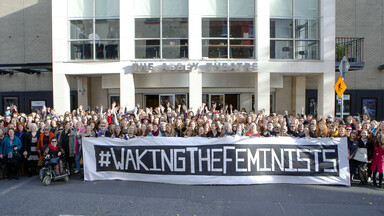
The iconic photograph outside the Abbey Theatre just before the first public meeting on 12 November 2015 showing a large crowd of women who work in all aspects of theatre, on and off-stage. The banner was made overnight by design student Molly O'Cathain and is now part of the National Museum of Ireland's #WakingTheFeminists collection. This photo has been used in numerous publications since that day, and a limited print edition was sold to raise funds for the campaign. It is now on the cover of 'WTF HAPPENED: #WakingTheFeminists and the Movement That Changed Irish Theatre', the book about the campaign by Sarah Durcan with Lian Bell, published by UCD Press in 2025. Photo: Fiona Morgan
Accessing the Collection
The Waking the Feminists born digital archive Collection documents this vibrant period through photographs and documentation, preserving not only the campaign itself but the wider cultural conversation it inspired.
A selection of the photographs can be explored through the Library’s catalogue: Waking the Feminists Collection.
In addition, archived versions of the campaign website are accessible through the Web Archive, with captures from January 2019 and November 2024 ensuring that the voices, visuals, and digital heritage of the movement remain discoverable for future generations.
Continuing the Conversation
This anniversary comes as the campaign’s story continues to be told. WTF HAPPENED: #WakingTheFeminists and the Movement That Changed Irish Theatre, a new book by Sarah Durcan and Lian Bell, documents the Waking the Feminists movement, and was launched at the NLI on 8th October 2025, further cementing the Library’s role as a steward of contemporary cultural history.
Dr Audrey Whitty, Sarah Durcan and Lian Bell at the launch of WTF Happened at the NLI. Photo: Mark Stedman

Sarah Durcan and Lian Bell at the National Library of Ireland. Photo: Mark Stedman
Join us by marking ten years of #WakingTheFeminists, a movement that continues to inspire conversations about equality, representation, and creativity in Ireland and beyond.
